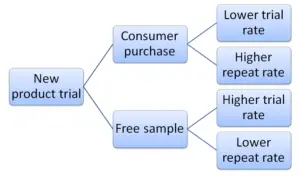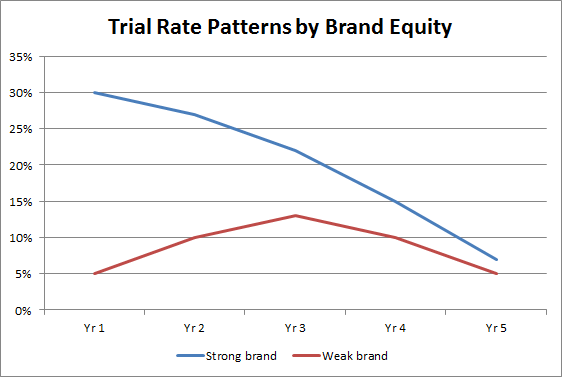Get the free ATAR forecasting model: Free Download: ATAR Model Excel Template
Contents
The T in the ATAR forecasting model stands for trial.
What is a trial?
A trial in marketing terms may mean slightly different things at times; therefore we need to clarify what is a suitable input into the ATAR model.
In most cases a trial refers to a first-time purchase by a consumer. This is where a consumer pays money for the product for the first time– either at the full rate or discount due to some form of sales promotion. Each consumer (or buying unit) can only have one trial in a period.
In terms of a low-cost product that you may find in a supermarket, consumers trialing new products is relatively common. For example, they see a new flavor or brand of soup on the shelf and decide to buy it for the first time. Based on this initial purchase – the trial purchase – the consumer will determine whether or not they will buy this brand/product on a more regular basis.
Is a free sample a trial in the ATAR?
In some cases, particularly for food and other low-cost products, a firm may engage in a product sampling promotion, where they hand out their product for free. This is another form of product trial.
This is an acceptable percentage to include in the ATAR model, as the consumer has actually trialed the product.
But TAKE CARE because many consumers will simply take the product because it is free, the corresponding repeat/rebuy percentage will be much lower than consumers who actually purchase the product with their own money (as the paying consumers are more interested in the product and see perceived value in it already).
Rule of thumb: High trial rate due to free product sampling = low repeat/rebuy rate. Low trial rate due to no up-front sales promotions/discounts = higher repeat/rebuy rate.
When using free trials in the ATAR forecasts it is also necessary to properly account for this discount in the overall/average price used.
The ATAR Excel template has been set up to assume that all trials are paid trials – therefore you will need to adjust the price input accordingly to reflect the true average price actually paid.
Trial purchases are very important
Because this is the consumer’s first direct interaction (experience) with the product/brand, the trial will significantly impact the consumer’s future behavior.
Positive trials – which result in positive customer satisfaction – are more likely to result in repeat purchase behavior. However negative trials – which result in negative customer satisfaction – are less likely to lead to purchase repeats.
What drives trial levels?
There are numerous factors that will impact the percentage of consumers that trial a product, which marketers can influence and drive. Some of the factors to take into account include:
- Is this a product line extension? Product line extensions would generally have higher trial rates.
- Does this new product belong to a strong brand? Strong brand equity leads to higher trial rates.
- Is there a free sampling program in place? Free sampling will deliver higher trial rates (but much lower repeat/rebuy rates – see section above).
- Are there sales and/or trade promotions in place? If yes, then trial rates will be higher.
- Is the product promoted/sold by a sales team? A dedicated sales channel will achieve higher trial take up rates.
- Does the firm/brand have the ability to direct market the new product to their existing customer base? If yes, then the trial rate should be high.
- Is this a relatively low-cost product? If yes, then trial rates will be higher.
- Is the product supported by advertising and wide availability? Seeing the product being promoted and available in stores gives the consumers confidence that this is a product that provides value and is a quality – leading to increased trial take up.
- Is the product unique/differentiated? Products that offer a new benefit are more likely to have a higher trial take up than “me too” competitors.
- Does the product have a money back guarantee? Money back guarantees will reduce the perceived risk to the consumer, and lead to increased initial sales.
- Does the overall new product provide a high level of perceived value? The higher the perceived value to the end consumer, then the higher the likely initial trial percentage.
Trial rates should generally reduce over time
When a product is first released, it probably has its best chance at maximizing its trial rate. This is because the product is new and exciting and the potential consumers that see value in the product are more likely to purchase it early.
This is particularly the case for product-line extensions and products under the support of strong brands.
Some lessor known brands might see an initial increase in trial rate in years 2 and 3, as positive word-of-mouth and greater product exposure gives more consumers the confidence to purchase the product. However, as indicated by the product life-cycle model, eventually the proportion of new/first-time customers will reduce.
The two trial scenarios described about are shown in the graph. Large brands will start higher, but then run off faster (but will generally always have a higher trial percentage). Whereas weaker brands will build for a while and then run off as well.
Use previous experience or a concept test for the trial numbers
Trial rates are best estimated based upon previous experience. Most firms have launched new products before, and their success or otherwise should be the basis of helping model sales and profit forecasts.
Certainly for product line extensions, the trial rate percentage used in the ATAR model should be quite similar to their previous experience.
In situations where the product is novel or where firm does not have direct experience with that sort of product – which also includes marketing student assignments – then a concept test can be utilized to derive/estimate a trial percentage suitable for use in the ATAR model.
A concept test is where an overview of the product idea (concept) is communicated to a potential consumer and then they are asked how likely they would be to purchase the product at least once.
This is typically done in some form survey to provide a statistical measure. A concept test also allows the company to get some understanding of any potential purchase hurdles (that is, perceived product weaknesses).
Find Out More About ATAR Forecasts
- Most ATAR factors are interrelated
- Benefits of the ATAR forecast model
- Limitations of ATAR forecasting
- Availability in ATAR Forecasts
- Trial in the ATAR Forecast
- Awareness in the ATAR Model
- Rebuy/repeat in the ATAR forecast model
- ATAR Examples for Two Small Businesses
- How the ATAR Forecasting Model Works
- ATAR Model: Guide to Prices, Costs, Margins, Quantity
- ATAR Theory
- ATAR Formula
- Buying Units in the ATAR Forecast Model


